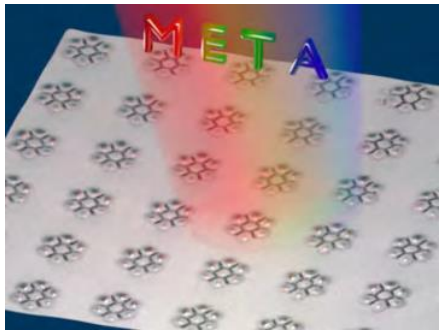Researchers enhance nonlinear effects of optical metasurfaces

Optical metasurfaces are thin-layer subwavelength-patterned structures that interact strongly with light. Offering a wealth of useful functionalities, they are a logical extension of the field of metamaterials towards their practical applications. Their nonlinear effects can be enhanced with the help of metasurface engineering.
The expression "metamaterials" is used for artificial materials that exhibit properties which cannot be observed in natural materials. Usually, their special characteristics do not arise from their chemical attributes but from the way their building blocks are arranged. In most cases, they are arranged in repeating patterns at scales smaller than the wavelengths of the phenomena they influence. By precisely adjusting their shape, geometry, size, orientation, and arrangement, materials with tailored properties can be achieved.
Two-dimensional thin-film planar structures composed of resonant metamaterial elements are called metasurfaces. "Metasurfaces have opened up recently our imagination for the realization of a new generation of flat optical elements with unique functionalities and numerous potential applications", Yuri S. Kivshar points out in a recently published review article. "Metasurfaces have become a new paradigm in the physics of metamaterials, showing many intriguing realizations of the metamaterial concept." Being a logical extension of the field of metamaterials towards their practical applications, metasurfaces have become the subject of several rapidly growing areas of research.
In their review, Kivshar and his co-authors from the Australian National University, Acton and the Lomonosov Moscow State University, Moscow, Russian Federation introduce the basic concepts, sum up important historical aspects, and give an overview on the most interesting properties of photonic metasurfaces, demonstrating their useful functionalities such as frequency selectivity, wavefront shaping, and polarization control. They discuss the ways to achieve tunability of metasurfaces and also demonstrate that nonlinear effects can be enhanced with the help of metasurface engineering.
One of the recent developments that may lead to a dramatic enhancement of metasurface performance is associated with the use of optically resonant dielectric metamaterial structures such as single-layer arrays of dielectric silicon disks. These resonant dielectric metasurfaces employ both electric and magnetic Mie resonances of high-index dielectric nanoparticles. The most remarkable example of an interplay of electric and magnetic Mie resonances can be found in the recently realized high-efficiency all-dielectric Huygens metasurfaces which can be employed for almost lossless wavefront manipulation and laser pulse compression. Another recent important direction of research on metasurfaces employs graphene and graphene-based structures as metasurface materials. For example, the nanostructuring of a graphene layer into an array of closely packed nanodisks was shown to enhance dramatically light absorption in the infrared region of the spectrum and this enhanced absorption can be tuned efficiently with voltage.
The authors anticipate that future technologies will demand a substantial increase in photonic integration and energy efficiency far surpassing those of bulk optical components and modern silicon photonics: "Such advances can be achieved only by embedding the photonic functionalities at the material level, creating a new paradigm of metadevices." Tunable photonic metasurfaces can add many new exciting functionalities (like variable focal length). Enhancement and engineering of nonlinear effects by metasurfaces can increase the efficiency of frequency mixing utilized in frequency up- and down-conversion processes as well as lead to novel ways for all-optical subwavelength control of light waves.
More information: "Functional and nonlinear optical metasurfaces." Laser & Photon. Rev., 9: 195–213. doi: 10.1002/lpor.201400402
Provided by Wiley





















